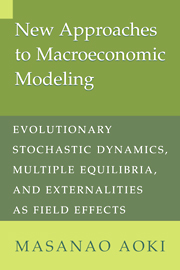 New Approaches to Macroeconomic Modeling
New Approaches to Macroeconomic Modeling Book contents
- Frontmatter
- Contents
- Preface
- Part I Introduction
- Part II Modeling Interactions
- 4 Modeling interactions I: Jump Markov processes
- 5 Modeling interactions II: Master equations and field effects
- 6 Modeling Interactions III: Pairwise and Multiple-Pair Interactions
- Part III Hierarchical Dynamics and Critical Phenomena
- Appendix
- References
- Index
4 - Modeling interactions I: Jump Markov processes
Published online by Cambridge University Press: 05 May 2010
- Frontmatter
- Contents
- Preface
- Part I Introduction
- Part II Modeling Interactions
- 4 Modeling interactions I: Jump Markov processes
- 5 Modeling interactions II: Master equations and field effects
- 6 Modeling Interactions III: Pairwise and Multiple-Pair Interactions
- Part III Hierarchical Dynamics and Critical Phenomena
- Appendix
- References
- Index
Summary
This and the next chapter describe applications of a class of stochastic processes, called jump Markov processes, to model evolutionary dynamics of a large collection of interacting microeconomic units that possibly use state-dependent discrete adjustment rules. This class includes branching processes or birth-and-death processes, to which we return in Chapter 5, to model the time evolution of rival technology adoption by firms in an industry.
Market participation and other discrete adjustment behavior
The economic literature has many examples showing that optimal adjustment behavior by microeconomic units is not always continuous or small. Rather, adjustments are made at some discrete points in time by some finite magnitudes. Similar adjustment behaviors are known to be optimal in several classes of problems in finance, operations research, and control. Many of these reported results show that adjustment or decision (control) rules are of the threshold type: A specific action or decision is chosen or triggered when some key variable, which measures the gap or discrepancy between a desired or ideal value and the actual one, reaches or exceeds (becomes larger or smaller than) some preset threshold or trigger level. Adjustments can be in one direction only, as in the well-known (S, s) inventory holding rule, or they can be more generally bidirectional; that is, adjustments could be upward or downward, as for example in Caballero (1992) where firms hire or fire as the gap between actual and desired levels of employment reach lower or upper bounds.
- Type
- Chapter
- Information
- New Approaches to Macroeconomic ModelingEvolutionary Stochastic Dynamics, Multiple Equilibria, and Externalities as Field Effects, pp. 81 - 112Publisher: Cambridge University PressPrint publication year: 1996


